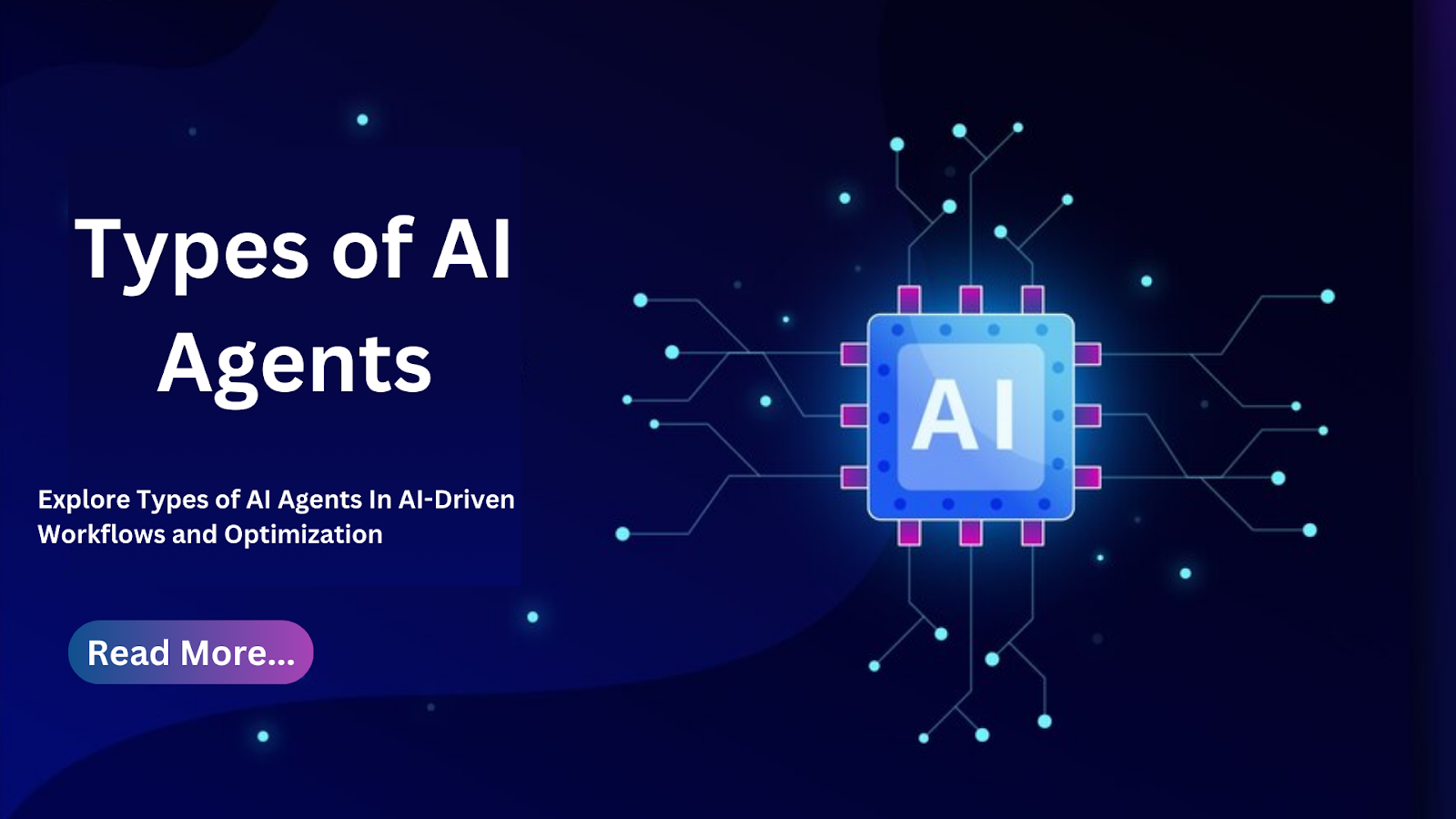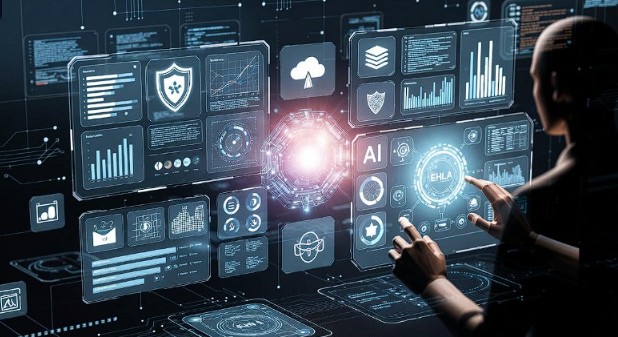
Introduction
Businesses nowadays rely heavily on automating the process, which is made possible by decision-making intelligent agents and enhancing interactions with customers. Without these intelligent agents, businesses often struggle with delayed decision-making, poor customer service, or high operation costs. As per the McKinsey report, companies using AI increased their productivity by 40% and reduced service costs by 25%. From a reactive to a fully autonomous agent, AI-driven solutions help streamline business operations with directions for improving efficiency. These agents analyze vast datasets and predict outcomes, leaving the system to do complex workflows. Want to know more about the types of AI Agents? Learn about them further.
Presenting You The Types of AI Agents
AI is transforming industries through intelligent automation and decision-making processes. Choosing the right type of AI agent for your business is paramount, as it directly impacts efficiency and growth.
The most effective way to deploy these agents is to hire AI Agent developers who can customize solutions to suit your needs. With proper guidance, companies can easily incorporate AI, which provides new avenues of innovation and success. For the categories of Agents, you will have more ideas from the points given below:
1. Simple Reflex Agents
Simple reflex agents make decisions only on the basis of the current sensory data without memory and learning. They rely on predefined condition-action rules to respond to environmental stimuli almost instantaneously. In this way, simple reflex agents would be highly efficient in predictable environments, where quick responses following rules are sufficient. However, they cannot change their behavior and learn to accommodate changes in their environment, which puts strict limits on their flexibility. This simplicity allows for easy design and implementation of reflex agents in simple automation tasks.
Use Cases:
- Motion sensors are used to trigger alarms if they detect movement.
- Automatic doors that detect a person nearby and open.
- Traffic signal systems change depending on whether there are vehicles present.
- Thermostats that are turned on and off based on temperature.
- Automatic email responders are subject to set rules.
.
2. Model-Based Reflex Agents
Model-based reflex agents. Model-based reflex agents are those reflexes in which the internal model keeps track of how the environment transforms over time. Unlike simple reflex agents, these agents can fill in the gaps in some missing information and make better decisions within partially observable environments. An internal model provides consequences of actions by improving adaptability, though without long-term learning and with pre-programmed rules. Such agents come in handy when one needs to make real-time decisions based on dynamic changes.
Use Cases:
- Smart home security systems can detect user behavioral anomalies.
- Network monitoring tools for irregularities in traffic patterns.
- Automated quality control systems in a manufacturing process.
- Virtual assistants that respond according to context.
- Robotic vacuum cleaners can be navigated using an internal map of the room.
3. Goal-Based Agents
Goal-based agents operate according to an explicit task and take actions that are dependent on that task. The agents can consider various sequences of actions and decide on the one that they believe would achieve the goal in the best way. In contrast to reflex agents, they apply reasoning and search techniques in their decision-making processes. These agents require well-specified goals and an environment capable of predicting future states. The ability of these agents to evaluate the long-term effects of current actions is what makes them helpful in solving problems.
Use Cases:
- Autonomous delivery drones optimize their path.
- Inventory management systems that schedule their own restocking.
- Self-driving cars that re-navigate during driving are based on efficiency.
- Smart homes optimally manage energy usage.
- Intent-based resolution of queries by automated customer service bots.
4. Learning Agents
Learning agents have improved their performance over time in an interaction process with their environment. They usually operate in a way that changes their behavior and makes better decisions based on the feedback they receive in the form of rewards and penalties. Unlike reflex and goal-based agents, learning agents are capable of handling situations for which they do not have any explicit programming. They use machine learning techniques to classify different patterns and to refine their responses. They are great examples of agents operating in environments in which the conditions under which they operate change frequently.
Use Cases:
- AI recommendation systems that improve the user experience.
- Chatbots that improve responses by previous log conversations.
- Fraud detection systems that can quickly learn new fraud patterns.
- Autonomous robots that increase the efficiency of movement with time.
- AI-based healthcare diagnostics that improve by running data through them.
5. Utility-Based Agents
Utility-based agents are those agents that select actions keeping in mind the maximum overall utility as opposed to a single goal. Such agents evaluate the possible values of outcomes, assign a numeric value to them according to desirability, and allow trade-offs among different objectives. These agents facilitate decision-making in critical scenarios, which cause a number of possible solutions that differ in their associated benefits. Their ability to weigh the different factors makes them generally better and more efficient in making decisions.
Use Cases:
- Ride-sharing algorithms optimize routes and pricing.
- Financial trading bots optimize profit while reducing risk factors.
- Smart grid energy distribution optimizes both cost and efficiency.
- AI-enabled healthcare scheduling optimizing doctors’ availability.
- Robotic systems make timely payment adjustments in unknown environments.
6. Hierarchical Agents
A hierarchical agent divides a complex task into several corresponding and manageable subtasks, all of which are then connected by a higher-level agent that coordinates the efforts of lower-level agents extending up to a certain point. It improves decision-making speed as well as execution speed which is ideal for multi-step processes. With these types of agents, devices are often used in environments that require worker activity houses organized into structured workflows with the benefit of modularity. It promotes a system that is easy to expand and maintain.
Use Cases:
- An industrial automation system has several stages of production.
- Military drones performing coordinated reconnaissance missions.
- Multi-tiered AIs in video game NPCs for complex decision-making.
- Smart traffic management systems coordinating multiple intersections.
- Autonomous warehouse robots, streamlining logistics and sorting.
7. Multi-Agent Systems (MAS)
Multi-agent systems comprise multiple AI agents that cooperate or compete in environments that they share. An agent communicates, shares knowledge with others, and makes decisions. In some systems, agents may share a common goal, while in others, they may compete for resources. MAS is essential in distributed computing environments, where individual agents may become ineffective when hurdles are encountered. The decentralized design ensures that MAS is highly scalable and resilient.
Use Cases:
- Swarm robotics is employed in disaster response and search operations.
- AI stock trading, where numerous bots analyze market conditions.
- Smart city infrastructure coordinating traffic lights and public transport.
- Multiplayer online gaming AI cooperates or competes with players.
- Supply chain optimization is when different agents handle various logistics tasks.
How Types of AI Agents Work
AI agents are designed to automate decision-making processes to enhance efficiency in a dynamic environment. They analyze data and adjust to changing situations, enabling businesses to make informed and trustworthy decisions. The following points will give you a better understanding of the functions of different types of AI Agents:
1. Perception and Input Processing
AI agents first gather and interpret data from their environment, including text inputs, voice commands, images, or sensor information. Technologies employed for this raw data interpretation are Natural Language Processing (NLP), computer vision, and speech recognition. For instance, a chatbot AI agent resolves customer queries by reading text contents, previous communications, and the intent. This context-setting phase ensures that the AI agent is made aware of the context prior to arriving at decisions.
2. Decision-Making and Planning
After processing inputs, AI agents employ machine learning models, rule-based systems, and predictive analytics to decide on the optimal course of action. Methods such as sentiment analysis, classification algorithms, and reinforcement learning enable agents to assess user intent and forecast the optimal response. For instance, an AI agent for support tickets evaluates urgency and customer sentiment to queue requests or forward them to human agents.
3. Knowledge Management
AI agents utilize knowledge bases, previous interactions, and external databases to provide accurate responses. These agnts also uses Retrieval-Augmented Generation (RAG) is to dynamically retrieve pertinent information from databases, product manuals, and FAQs. It helps in the sector like healthcare were virtual assistant can retrieve treatment protocols from a medical database, for instance, to offer authoritative patient assistance. This makes AI agents provide fact-based and context-aware responses.
4. Action Execution
Once a response is chosen, AI agents perform actions like automated responses, database updates, workflow triggers, or system commands. The execution module guarantees well-formatted and efficient delivery of responses. For example, an e-commerce AI assistant can recommend products, update orders, or inform users about shipping status. This process closes decision-making with real-world implementation.
5. Learning and Adaptation
In this stage, AI agents learn in real time through feedback analysis, performance monitoring, and knowledge base updation. Through reinforcement learning, self-supervised learning, and user feedback loops, they optimize responses and decision-making protocols. For instance, a recommendation AI learns to suggest more suitable products based on user preferences and purchase history. Adaptive learning enhances accuracy and customization for this purpose.
Future of Types of AI Agents
The future of AI agents is evolving towards greater autonomy, adaptability, and intelligence. With the progress of ML and deep learning, AI agents will be more context-sensitive, making more advanced decisions with limited intervention from humans. Multi-agent systems will increase coordination among industries, ranging from smart cities to autonomous supply chains. Hierarchical and utility-based agents will make resource management more efficient, optimizing energy usage and financial planning. The combination of AI with quantum computing and edge computing will further increase real-time processing and decision-making capacity. As ethical and security issues increase, AI agents will also include stronger protections for transparency, accountability, and bias mitigation.
Conclusion
From the above blog we have got the idea that how different types of AI Agents reshapes industries through automation, optimization, and efficiency. Automated processes build on the optimization of decision-making and overall productivity. As technology progresses, these systems are getting smarter and becoming adaptive, collaborative, and able to handle more complicated problems with minimal human interference. A company that employs AI agents in its march could pave the way for a competitive edge through productivity enhancement and innovation. If your business also wants to take advantage of the advancement of AI Agents and their types, then investing in AI Agent Development services could help you implement tailor-made solutions for your needs. Embracing AI-driven automation today will help ensure future success in a digital world.
Write and Win: Participate in Creative writing Contest & International Essay Contest and win fabulous prizes.


